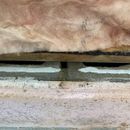Sealing Gaps in Cinderblock Foundation
This maybe an odd question for this forum but here goes:
I’m about to start framing the interior walls of my double stud construction. My exterior 2×6 stud walls are built on a cinderblock foundation. The portion of the cinderblocks that aren’t covered by the walls (about 2″) are covered with foam insulation, but underneath that foam are the large hollow gaps in the cinderblocks. I’ve attached a couple pics here to describe what I’m talking about.
I know that various critters (bugs, spiders, etc) can come up through those gaps as I’ve seen it happen. My concern is that I don’t want any of those critters living rent free inside by double stud walls, so I need someway of sealing or blocking those gaps so that nothing can get in once the double stud walls are up. I’m going to keep the insulation on there but it doesn’t provide a very good seal so I’ll need to remove the insulation, seal it, then put it back.
I’ve considered using spray foam although that will be a ton of spray foam and probably not the best method. I could also lay something on top such as Tuck Tape but not sure that would hold up long term. Or maybe some 6 mil poly?
Can anyone suggest the best way to seal up or cover these holes? Appreciate any advice!
GBA Detail Library
A collection of one thousand construction details organized by climate and house part











Replies
I might bend a piece of metal flashing into an "L" shape to cover the holes, fastened to the plate, then lay mortar to create a slope covering the flashing and the exposed edges of the CMU. The mortar will eventually separate from the wooden plate, not a lot but enough for air flow and possibly for bug movement., so after it dries I would cover it with a vapor-permeable but airtight tape, sealed to the wooden plate.
I like this idea a lot. I'm not sure I quite understand the "slope" but I think I have a pretty good idea of how it all might work. I'll be covering it all back up with foam insulation so I'll need something relatively thin and flat. The metal flashing is a great idea. Thanks!
A bead of polyurethane sealant between the flashing and the wood framing, and a heavy bead of the same sealant on the top of the masonry will go a long way to air and bug sealing the edges of the flashing. I would mechanically fasten to the framing through the sealant too, so that the sealant oozes around the fasteners and seals them too.
BTW, I the electric caulk guns make long beads of thick sealants a lot easier to apply, and they help you to do a better job too. I used to think they were a joke until I actually tried one...
Bill
Just a quick update and follow up question. I bought some 2” x 1” aluminum angle that’ll work out nicely. I had to change the plan a bit from attaching it to the bottom plate because the insulation on top of the CMU’s was affixed with construction adhesive that won’t come off so it wouldn’t lay flat. But, it’s the perfect size to lay down the other way with the short angle tucked under the remaining insulation on the vertical face of the foundation. Just got to caulk around the edges now.
Regarding the gap between the slab and the foundation insulation, it’s pretty minimal but I’d like to seal that too. The slab has radiant heating. Is a silicon sealant suitable for this purpose?